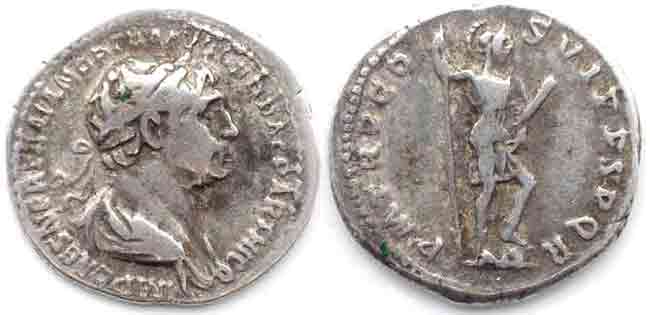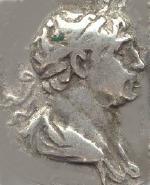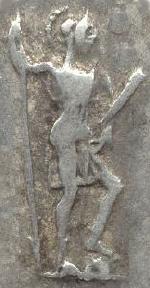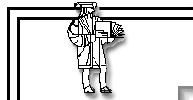Anatomy of a Roman Coin

17.6 x 19.1 mm. 3.50 grams
Many collectors new to Roman coins might view this denarius of Trajan as simply a portrait of Trajan, with a Roman soldier on the reverse. They might give little thought beyond add the portrait of Trajan to their Roman portrait collection, not realizing this coin has a story to tell about what was happening in the Roman Empire when it was struck. All they need to is read the inscription, look at the images and that story can come back to life after almost 2000 years.
The Story Begins on the Obverse
 | The emperor's portrait is normally the first thing most people look at on any Roman coin, in this case it is easily recognized as that of Trajan. His dignified look befits his position as emperor and just so there can be no confusion he wears a laurel wreath in his hair, known as the Laureate Corona" which since the Republican period was conferred only on those who had achieved the highest pro-consular dignity. Around 44 BC Julius Caesar reserved it as a symbol of the supreme ruler then Augustus made it the a symbol of the emperor, conferred only on those holding the title of "Augustus". |
Just in case someone was not familiar with the portrait he conveniently tells us via the obverse and reverse inscriptions exactly who he is and what titles he holds. Starting at 6 o'clock and reading clockwise around, we find the following:

IMP
IMPERATOR | This has two meanings. It is a praenomen of the Emperor indicating he is Emperor and supreme commander of the Roman Army. Not unlike the title Commander-in-Chief bestowed on US presidents. This is the context in which it appears on this coin. On other Roman coins it can also be a title awarded to Emperors who win important military victories but in that context it will normally be followed by a number indicating how many times it has been awarded to him. |

CAES
CAESAR | This started as the family name of Julius Caesar, assumed by Augustus when Caesar adopted him, becoming part of the name of members of Julio-Claudian house that ruled Rome until Nero's death. Following Nero CAESAR became a title meaning a person of great dignity and a dignitary of the second rank below the Emperor, but was retained on becoming Emperor and thus just indicated a person of great dignity. Trajan was awarded this title in October of AD 97 three months before becoming Emperor. |

NER
NERVA | Trajan was the adopted by the Emperor Nerva in October of AD 97, adding NERVA as part of his name. |

TRAIAN
TRAJANUS | Trajan's full birth name was MARCUS ULPIUS TRAJANUS, so here he is just telling us who he is. |

OPTIM
OPTIMUS PRINCEPS | Means "the most perfect prince", a title awarded to Trajan by the Senate in AD 100 on re-entering Rome following the German wars. It appears to have been very important to Trajan as it appears on many of his coins, sometimes spelled out in full on the reverse. |

AVG
AUGUSTUS | This title, AUGUSTUS, originally mean "worthy of veneration" but when conferred on Octavian as the first Roman Emperor, it became a title indicating the Sovereign or high ruler. Trajan was awarded this title in January of AD 98, defining him as Emperor. |

GER
GERMANICUS | Means Victor over the Germans and was awarded to Trajan in AD 98 following his German victory of AD 98. |

DAC
DACICUS | Means "Victor over the Dacians", a title awarded to Trajan following his victories in his first Dacian war of AD 101-102. |

PARTHICO
PARTHICUS | Means Victor over the Parthians, a title awarded to Trajan following his victories over the Parthians in AD 116. For dating this coin Parthicus is the most important title on the coin as it tells us the coin cannot have been issued prior to AD 116. |
The obverse inscription expanded from it's abbreviations becomes: IMPERATOR CAESAR NERVA TRAIANUS OPTIMVS PRINCIPI AUGUSTUS GERMANICUS DACICUS PARTHICUS, meaning The supreme commander of great dignity, Nerva Trajanus, the most perfect prince and sovereign, victor over the Germans, Dacians and Parthians.
The Story Continues on the Reverse

P M
PONTIFEX MAXIMUS | Means High Priest, a title putting Trajan in charge of Roman religion and sacred ceremonies. Trajan assumed on becoming Emperor in AD 98. |

TR P
TRIBUNICIA POTESTAS | Means "Tribune of the People". Officially this means Trajan was protector of the rights of the plebeians, but in reality it allowed him to do almost anything he wished to do. It not only gave him the power to convene or dismiss the Senate, but included veto power over the Senate's decisions. The title was renewed annually and while not the case on this coin, on some coins it is followed by a number indicating how many times it had been renewed and on such coins can be used to accurately date them. |

COS VI
CONSUL VI | Means Consul for the sixth time. The title of Consul originates early in the Republic period when a Consul was the highest magistrate with a great deal of power. Under the Empire the power of the consuls was greatly diminished, with the title more one of show than power. Most Emperors held the title, which was renewed periodically and helps to date many coins. Trajan became Consul for the 6th time in AD 112 but stayed at that number for the balance of his reign. |

P P
PATER PATRIAE | Means "father of his country" and was a purely honorary title only some Emperors used, and did not confer any additional powers. |

S P Q R
SENATUS POPULUSQUE ROMANUS | Means "The Senate and the Roman People". This is not a title but rather part of a much larger meaning in the context of the other titles, which will be made clear below. |
When expanded from it's abbreviated form the reverse inscription becomes: PONTIFEX MAXIMUS TRIBUNICIA POTESTAS CONSUL VI PATER PATRIAE SENATUS POPULUSQUE ROMANUS. which means: High priest, Tribune of the People, Consul for the sixth time, Father of the country, as recognized by the Senate and the people of Rome.
 | On understanding the inscriptions one must examine the reverse design to complete the understand of what the Emperor is trying to say to his people. On this coin is a standing figure of VIRTUS, the Roman personification (an idea given human form) of the attributes of valor, manliness, excellence, courage, character, and worth. In this case Virtus is wearing military garb, holding a parazonium (a sword like weapon) and spear. What is easy to overlook, but very important on this coin, is the spear is held in a transverse position with the point down, symbolizing peace as there is no imminent battle where the spear might be needed.
One can take this to have two meanings as it is not clear if Virtus symbolizes the courage of the Emperor has brought peace, or the courage of the Emperor's army has brought peace. Both may be correct at the same type. |
Fitting It All Together
When taken as a whole this coin is like a front page newspaper story:

THE ROMAN TIMES
In the 19th year of our Emperor
PEACE COMES TO THE EMPIRE
|
The supreme commander of great dignity, Nerva Trajanus, the most perfect prince and sovereign, who brought you victory over the Germans and Dacians, is High Priest, Tribune of the People, Consul for the sixth time, Father of the country, as recognized by the Senate and people of Rome, through his great courage, and the courage of our military under his command, a great victory has been achieved over the Parthians and thus the Senate has conferred on him the title of PARTHICUS. Together with his earlier victories there is now peace across the Empire. |
|



